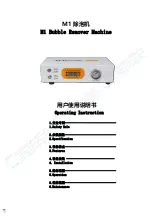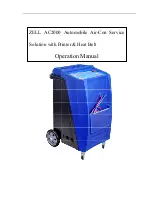
Transmission Overhaul
As the transmission components are removed for ser-
vice and inspection, it should be noted that nominal
wear to the components is acceptable. Critical contact
surfaces (i.e. charge pump gerotor, piston slippers, etc.)
must be in good condition or the system will be
inefficient.
When components have circumferential scratches or
grooves noted on the running surfaces, it is an indication
of foreign material in the hydraulic oil.
If upon inspection of the critical contact surfaces you
notice circumferential scratches that might be removed
by a minimum amount of polishing or touch lapping;
rework and use them again.
When scratches or grooves can be detected by "feel"
with a fingernail or lead pencil, the part should be
replaced. Polishing or touch lapping can be ac-
complished using 4/0 grit sandpaper on a flat lapping
table (table must be kept flat). Polish parts using polish-
ing solvent or equivalent. Do not polish parts dry.
IMPORTANT: Lapping plate must be flat within
0.00005 inch.
Separating Transmission Into Sections (Fig. 23)
The transmission must be separated into three main
sections to perform major overhaul. The three sections
are: pump section, center section, and motor section.
NOTE: The following procedures are for major overhaul
of the in-line transmission. Servicing the charge pump,
seals and valves is covered on previous pages.
1. Before separating the transmission, scribe or paint an
alignment mark on each housing to assure correct
reassembly of the sections.
2. Remove the four cap screws in small increments so
the three main sections separate evenly. As the cap
screws are loosened, oil will drain from the housings.
NOTE: When the cap screws are first loosened, an
internal spring load causes the sections to separate
slightly.
3. When the four cap screws are removed, pull the motor
housing away from the center section. Do not let the
internal parts fall out of the housing because damage
may result.
NOTE: The motor valve plate will probably adhere to the
side of the center section. Do not let it fall when separat-
ing the motor housing from the center section.
4. Remove the motor valve plate and gasket.
5. Set the motor housing and motor valve plate aside.
6. Pull the pump housing away from the center section.
Do not let the internal parts fall out of the housing
because damage may result.
NOTE: The pump valve plate will probably adhere to the
side of the center section. Do not let it fall when separat-
ing the pump housing from the center section.
7. Remove the pump valve plate and gasket.
8. Set the pump housing and pump valve plate aside.
Keep the pump valve plate separate from the motor
v
a l v
e p l
a t
e b e
c
a u
s
e
interchangeable.
t
h
e s
e p a
r
t
s a r
e n
o t
Keep the motor valve plate separate from the pump
Figure 23
v
a l v
e p l
a t
e b e
c
a u
s
e t
h
e s
e p a
r
t
s a r
e n
o t
interchangeable.
Repairs
Page 5 - 34
Groundsmaster
®
300 Series
Summary of Contents for Groundsmaster 328-D
Page 2: ......
Page 12: ...Torque Specifications Page 2 4 Rev A Groundsmaster 300 Series ...
Page 44: ...Troubleshooting Page 4 16 Groundsmaster 300 Series ...
Page 45: ...Groundsmaster 300 Series Page 4 17 Troubleshooting ...
Page 171: ...Groundsmaster 300 Series Page 6 25 Testing ...
Page 220: ...Repairs Page 7 24 Groundsmaster 300 Series ...
Page 320: ...Troubleshooting Troubleshooting Page 11 4 Groundsmaster 300 Series ...
Page 348: ...Troubleshooting Troubleshooting Page 12 4 Groundsmaster 300 Series ...
Page 379: ...Troubleshooting Groundsmaster 300 Series Page 13 3 Troubleshooting ...
Page 400: ...This page is blank ...
Page 401: ...This page is blank ...
















































